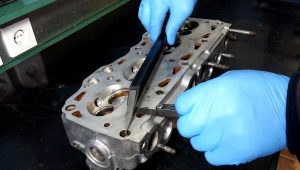Cylinder Head Repair
The cylinder head is exposed to various problems that adversely affect the operation of the engine. Constant thermal cycles of heating and cooling over time can distort the cylinder head causing leakage of compression, coolant, and oil. Possible faults are loosening of the cylinder head and valve seals, cracks on the cylinder head, deformation of the cylinder surface, burnt and distorted valves, or damage to the spark plug thread. With a camshaft motor, the camshaft bearing and camshaft bearing bore can be damaged.
When the seals loosen, coolant, oil, and compression gases penetrate other parts of the engine. The cylinder head must be removed and the seal replaced.
Cracks in the engine head are a serious problem that is very common due to its light construction. The main cause of cracks is thermal stress. During heating, the metal expands. The cylinder head is designed to withstand a certain expansion, and their fastening or set screws follow that expansion to a certain extension. As long as the engine is within the permissible operating temperature, the expansion and elongation are within the permitted limits. When a temperature increase occurs due to a fault in the cooling system, the elongation of the cylinder head and bolts exceeds the design limit. Over time, it can cause deformation of the metal, causing cracks to form. Depending on the location of the crack, coolant, oil, suction fuel, and air mixture or exhaust fumes can penetrate from the head into the surrounding engine parts. The block and cylinder head pressure test identifies hard-to-see cracks. The analysis of the detected crack determines the degree of damage and makes a decision whether to repair or replace the cylinder head.
Due to thermal stresses, the sealing surface of the cylinder head, sleeve bearing, and camshaft bearing opening may bend. Special machining procedures can be used to correct deformities caused on the cylinder head.
Damaged valves and valve seals can sometimes be repaired and reused. However, the price of new valves has dropped significantly so replacement is a common option for new vehicles. Older vehicles for which no spare parts are available to require refurbishment that includes cleaning, defect detection, and handling. The machining process requires special equipment and a skilled machinist.
Repair and repair of damage to the cylinder head are performed by experts using appropriate methods through machining.
This section describes the procedures for overhauling, testing, and determining the fault on the cylinder head.














